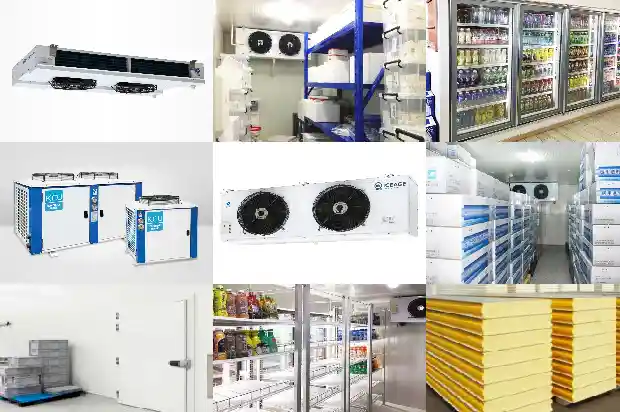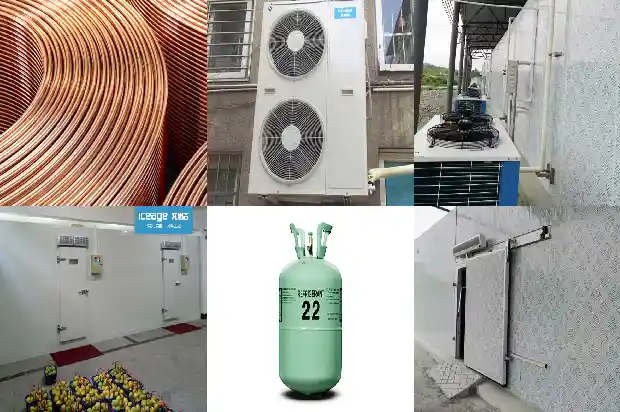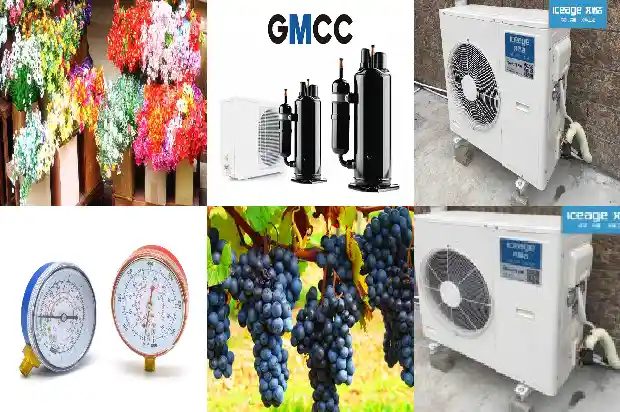Do You Know the Ten Common Fault Causes of the Refrigeration System?
2025-04-15
I. Liquid Return
- For the refrigeration system using an expansion valve, liquid return is closely related to the improper selection and use of the expansion valve. Oversized selection of the expansion valve, too small superheat setting, incorrect installation method of the thermal bulb, damaged thermal insulation wrapping, or malfunction of the expansion valve may all cause liquid return.
- For a small refrigeration system using a capillary tube, an excessive amount of liquid charging will cause liquid return. When the frost on the evaporator is severe or the fan fails, the heat transfer deteriorates, and the unevaporated liquid will cause liquid return. Frequent temperature fluctuations can also cause the expansion valve to malfunction and cause liquid return.
For refrigeration systems where liquid return is difficult to avoid, installing a gas-liquid separator for control can effectively prevent or reduce the harm of liquid return.
II. Liquid-Carrying Start - The phenomenon of violent foaming of the lubricating oil in the compressor is called liquid-carrying start. The foaming phenomenon during liquid-carrying start can be clearly observed on the oil sight glass. The root cause is that a large amount of refrigerant dissolved in the lubricating oil and settled below the lubricating oil suddenly boils when the pressure drops suddenly, and causes the foaming of the lubricating oil, which can easily cause liquid slugging.
- Installing a crankcase heater (electric heater) on the compressor can effectively prevent refrigerant migration. For a short-term shutdown, keep the crankcase heater powered on. After a long-term shutdown, heat the lubricating oil for several or more than ten hours before starting the machine. Installing a gas-liquid separator on the return air pipeline can increase the resistance to refrigerant migration and reduce the migration amount.
III. Oil Return - When the compressor is higher than the evaporator, an oil return bend on the vertical return air pipeline is necessary. The oil return bend should be as compact as possible to reduce the oil storage. The spacing between the oil return bends should be appropriate. When there are a relatively large number of oil return bends, some lubricating oil should be replenished.
- Frequent starting of the compressor is not conducive to oil return. Since the compressor stops after a very short continuous operation time, a stable high-speed airflow has no time to form in the return air pipeline, and the lubricating oil can only stay in the pipeline. If the oil return is less than the oil carryover, the compressor will be short of oil. The shorter the operation time, the longer the pipeline, and the more complex the system, the more prominent the oil return problem will be.
- Lack of oil will cause serious insufficient lubrication. The root cause of oil shortage does not lie in the amount and speed of oil carryover of the compressor, but in the poor oil return of the system. Installing an oil separator can return oil quickly and extend the operation time of the compressor without oil return.
IV. Evaporation Temperature
The evaporation temperature has a great impact on the refrigeration efficiency.
For every 1-degree decrease in it, the power needs to be increased by 4% to produce the same cooling capacity. Therefore, under the permitted conditions, appropriately increasing the evaporation temperature is beneficial to improving the refrigeration efficiency of the air conditioner.
The evaporation temperature of a household air conditioner is generally 5 to 10 degrees lower than the air outlet temperature of the air conditioner. During normal operation, the evaporation temperature is between 5 and 12 degrees, and the air outlet temperature is between 10 and 20 degrees.
Blindly reducing the evaporation temperature can increase the refrigeration temperature difference, but the refrigeration capacity of the compressor decreases. Therefore, the refrigeration speed is not necessarily fast. Moreover, the lower the evaporation temperature, the lower the refrigeration coefficient, while the load increases, the operation time is prolonged, and the power consumption will increase.
V. Excessively High Discharge Temperature
The main reasons for the excessively high discharge temperature are as follows: high return air temperature, large motor heating amount, high compression ratio, high condensing pressure, adiabatic index of the refrigerant, and improper selection of the refrigerant.
VI. Liquid Slugging - To ensure the safe operation of the compressor and prevent the occurrence of liquid slugging, it is required that the suction temperature is a little higher than the evaporation temperature, that is, there should be a certain superheat.
- It is necessary to avoid the suction temperature being too high or too low. If the suction temperature is too high, that is, the superheat is too large, it will lead to an increase in the discharge temperature of the compressor. If the suction temperature is too low, it means that the refrigerant does not evaporate completely in the evaporator, which not only reduces the heat exchange efficiency of the evaporator, but also the inhalation of wet steam will form liquid slugging in the compressor. Under normal circumstances, the suction temperature should be 5 to 10℃ higher than the evaporation temperature.
VII. Refrigerant Charging - When the amount of refrigerant is small or its regulating pressure is low (or partially blocked), the valve cover (bellows) of the expansion valve, and even the liquid inlet will frost; when the amount of refrigerant is too small or there is basically no refrigerant, there is no reaction on the surface of the expansion valve, and only a little hissing sound of the airflow can be heard.
- Observe from which end the icing starts, whether it is from the liquid distribution head or from the compressor return air pipe. If it is from the liquid distribution head, it means there is a refrigerant shortage, and if it is from the compressor, it means there is too much refrigerant.
VIII. Low Suction Temperature - The refrigerant charging amount is too large, occupying part of the volume in the condenser, which increases the condensing pressure, and the liquid entering the evaporator increases accordingly. The liquid in the evaporator cannot be completely vaporized, so that the gas inhaled by the compressor contains liquid droplets. In this way, the temperature of the return air pipeline decreases, but the evaporation temperature does not change because the pressure has not decreased, and the superheat decreases. Even if the expansion valve is closed slightly, there is no significant improvement.
- The opening degree of the expansion valve is too large. Due to the loose binding of the temperature sensing element, small contact area with the return air pipe, or the temperature sensing element not being wrapped with thermal insulation material and its wrong wrapping position, etc., the temperature measured by the temperature sensing element is inaccurate and close to the ambient temperature, causing the opening degree of the expansion valve to increase, resulting in an excessive liquid supply.
IX. High Suction Temperature - The refrigerant charging amount in the system is insufficient, or the opening degree of the expansion valve is too small, resulting in an insufficient circulation amount of the refrigerant in the system. The amount of refrigerant entering the evaporator is small, the superheat is large, and thus the suction temperature is high.
- The filter screen at the expansion valve port is blocked, the liquid supply amount in the evaporator is insufficient, the amount of refrigerant liquid decreases, and part of the evaporator is occupied by superheated steam. Therefore, the suction temperature rises.
- Other reasons cause the suction temperature to be too high. For example, poor thermal insulation of the return air pipeline or too long pipeline can all cause the suction temperature to be too high. Under normal circumstances, the cylinder head of the compressor should be half cold and half hot.
X. Excessively Low Discharge Temperature
The excessively low discharge pressure, although the phenomenon is manifested at the high-pressure end, the reasons mostly occur at the low-pressure end. The reasons are: - Ice blockage or dirt blockage of the expansion valve, and blockage of the filter, etc.
, will inevitably cause both the suction and discharge pressures to drop;
Insufficient refrigerant charging amount; - The expansion valve hole is blocked, the liquid supply amount is reduced or even stops. At this time, both the suction and discharge pressures are reduced.
Related Articles
- Top Ten Common Faults of the Refrigeration System: Analysis and Solutions Included!
- A Summary of 11 Common Faults in Refrigeration and Air Conditioning Systems
- Operation: Analysis of 20 Major Faults of Screw Compressors!
- Analysis and Solutions for Common Faults in Refrigeration Systems
- Structure and Common Faults of Hermetic Compressors
- Common Faults and Solutions in Cold Storage Maintenance
- Common Faults and Treatment Methods of Single-phase Asynchronous Motors
- These Are the Nine Reasons for the Low-pressure Fault! Haven't You Mastered Them Yet?
- Common Faults and Daily Maintenance of Commercial Ice Makers
- Analysis of Common Faults of Chillers
- Wiring Methods, Faults and Classifications of Fan Coil Units, All Here~~
- Eliminate the "Blockage" Faults (Ice Blockage, Dirt Blockage, Oil Blockage) of the Refrigeration System in 5 Minutes
- Common Fault Causes and Solutions of Cold Storage Systems
- Common Fault Causes of Totally Enclosed Refrigeration Compressors
- Common Fault Causes and Replacement of Multi-connected Unit Compressors
- How to Inspect and Troubleshoot the Faults of the Control Valve in the Cold Storage?
- Common Faults in Refrigeration Systems and Handling Methods
- What Are the Common Causes of High - pressure Faults in Chillers?
